
Dave Gibson was a freshman the year the campus closed.
by Dave Gibson ’73
Bio: Dave Gibson graduated from Ohio University in 1973 and became a high school history teacher. For most of his career, he worked as an administrator for SOITA Learning Technologies in Oxford, Ohio. He received a master’s degree from Wright State University in 1981 and was named WSU’s 2004 outstanding alumnus in educational administration. He ended his Ohio education service in 2012 as governing board president of the Butler County Educational Service Center. He now resides in Florida with his wife, Joelle.
Acclimating to a Growing Campus
I entered OHIO as a freshman in the fall of 1969. I lived in the all-freshman Grosvenor Hall, now the College of Osteopathic Medicine, on West Green. Life at OHIO that fall and winter was pretty typical college life of the 1960s, similar to the high jinks portrayed in the movie “Animal House.”
OHIO had full enrollment—15,000+ students in Athens. Most of the closet-sized rooms at Grosvenor were triple bunked. There was a lot of beer drinking going on among most students uptown at 40 or so student bars. No drinking was allowed in the dorms. In Ohio, 18-year-olds could drink 3.2 percent alcohol beer at the time, and Stroh’s Beer (America’s Only Fire-Brewed Beer) was OHIO’s favorite.
In terms of campus activities, there was a tremendous amount of construction going on. The Convo was almost brand new, as was Alden Library. New South Green was being constructed, and the Hocking River was being moved. The football team wasn’t very good, but basketball was top rate. The rock group The Who played in the Convo in late 1969, just a few months after they performed at Woodstock. As they did at Woodstock (later captured in the feature film), they performed selections from the rock opera, “Tommy.”
The Hocking River flooded for the last time that spring of 1970. Students who had cars parked in the first floor garages of West Green returned from class in the afternoon to find their cars surrounded by a foot or so of water. Someone in Grosvenor played their stereo out the window with Simon & Garfunkel’s “Bridge Over Troubled Waters” blasting as student drove their cars out of the garages. Students on the West Green bridges cheered as they drove out. One guy put down his convertible top as he plowed through the waters to the delight of the crowd.
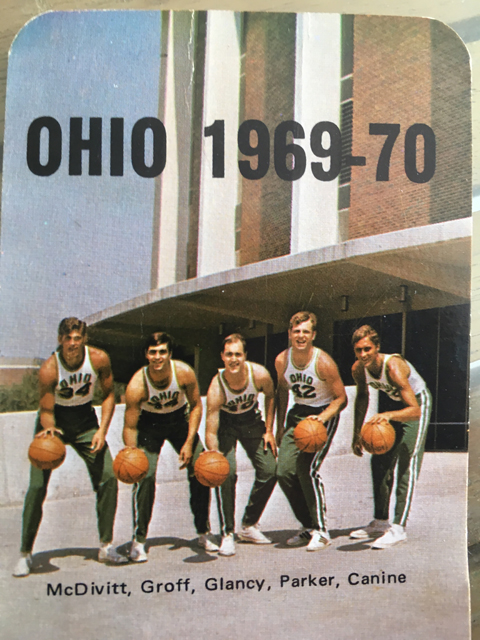
College Life During Vietnam
All of the OHIO men were granted a 2S student deferment from the military draft. Registering for the draft was mandatory, and we all carried draft cards indicating our deferred status. The Vietnam War was right about at its peak of American involvement. Needless to say, anti-war sentiment among students and professors ran high. Many people in America at the time regarded those who were anti-war as anti-American. A popular bumper sticker was “America, Love It or Leave It.” An 18- to 22-year-old American male who was not in college would have been classified 1-A and subject to induction into the military. It should be noted that voting age at the time was 21, so you could be drafted into the army at 18 but you had no right to vote until you were 21.
I believe probably close to a third of the students in my floor section in Grosvenor were not really “college material.” They were at OHIO to test the waters, see if college was for them and most definitely to get their 2S deferment. I know that several of these students dropped out of college over the next two to three years. America moved from a military draft to a lottery system during this time.
OHIO women didn’t have to register for the draft, but they did have “hours.” Freshmen women had to be back in their dorms by 11 p.m. on weeknights and midnight or 1 a.m. on weekends. I don’t know if this rule applied to upper-class women. I don’t remember what penalties women endured if they broke curfew.
Of course, this was before any electronic social media like we have today. We didn’t even have TVs in our dorm rooms. Most dorms had one TV in a lounge area. Our news and information came from the Post student paper and WOUB radio. We had discussions in our classes and in other social settings, like the cafeterias. Paper fliers were passed out on campus announcing student protest activities.
A Personal Connection to OHIO
My grandmother, Grace Morrison Gunning, died during my freshman year; I later found out she had attended OHIO in the summer of 1914, just prior to World War I. Along with hundreds of other young women from all over Ohio, she completed six weeks of coursework that qualified her to become a one-room schoolhouse teacher. She was part of a huge effort by the state of Ohio in the early 1900s to upgrade and improve rural schooling. I have thought of how her OHIO experience would have differed from mine: traveling to Athens by train and no air conditioning anywhere, in hot, humid, summertime Athens! What a brave young woman to make this journey, complete the coursework, and return to Madison County to teach.
Politics and Protests—Campus Unrest Begins
I remember the spring of 1970 emerging as pretty typical college life. There was some student activism not war-related. I believe this was the year of the first Earth Day. Students went around putting bumper stickers on cars that said, “This Is a Polluter.”
I also remember images of students being driven around Athens hanging on the sides of beer delivery trucks and collecting trash. Student groups representing dorms, frats, and sororities collecting the most trash won prizes (free beer, I believe!).
In addition, that spring, OHIO administration announced a tuition increase for the next academic year. This didn’t go over well with the student body. A protest group of maybe 200 students gathered in front of Cutler Hall. I remember a confrontation between students and Ohio Highway Patrol officers. Students were ordered to disperse. I was standing there between classes and saw a student I knew get arrested. I moved on soon after that!
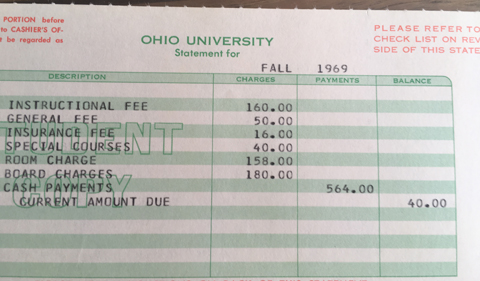
Tuition statement from Fall 1969
‘Nixon Has Gone Mad!’
Anti-war activities became more active in April of 1970. The increased bombing in Vietnam and Cambodia was unpopular. I remember a flier handed to me on campus saying “Nixon has gone mad!” Then it announced a planned protest somewhere on campus. I remember students were trying to organize a “strike” of attending classes. Some professors countered this by suspending regular classroom activities and subject matter and devoting class time to discussing current political issues.
I remember participating in an anti-war protest march that snaked through the College Green and through downtown Athens at some point. It was totally peaceful with around 400 to 500 students.
I have a faint memory of students breaking in and occupying Chubb Hall, the former library, that was not being utilized by the university at the time.
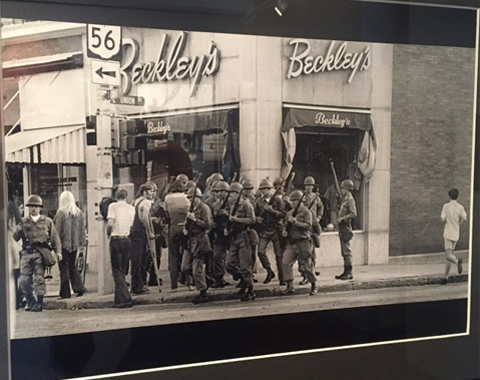
1970 student protest in front of Beckley’s
Kent State Shootings Prompt OHIO Protests
Things began to escalate as far as events around campus were concerned. This may have occurred before May 4, the date of the Kent State University shootings, and they definitely happened after that date. “Events” included dumpster fires and fire alarms being set off in dorms, particularly at night. I remember seeing students burning their draft cards close to the Civil War Memorial on the College Green. (The memorial was a focal point of student communication and unrest.)
College campuses around the country were erupting in protests, and some were violent. More shootings of students occurred at Jackson State College in Mississippi.
A few days after the Kent State shootings, students began gathering at Court and Union in the evening. The purpose may have been to block traffic as part of a war protest session. (This was during the time when a lot of traffic was still routed through downtown Athens, unlike today where some of the out-of-town traffic bypasses Athens.) These student gatherings were met by local police in riot gear.
‘How Could This Have Happened?’
Although students had been angry about the war escalation in recent weeks, they got really angry after the Kent State shootings, especially since this happened at a sister institution in Ohio. I believe everyone was thinking, “How could this have happened?”
There was at least one night of student-police confrontation before the night Ohio University closed. The “pre-riot” was just a warm-up for the real thing. I believe Nelson Dining Commons, under construction, was set afire during the pre-riot activities.
On the night of closure, students were in my dorm showering and getting ready to go uptown. In all honesty, motivations could probably be attributed to a wide spectrum of things. Part war protest, anger about Kent State, part typical spring college revelry (alcohol-fueled), part anti-police/authority figure feelings, part anti-college bookstore sentiments (which captured a lot of student money), and so on.
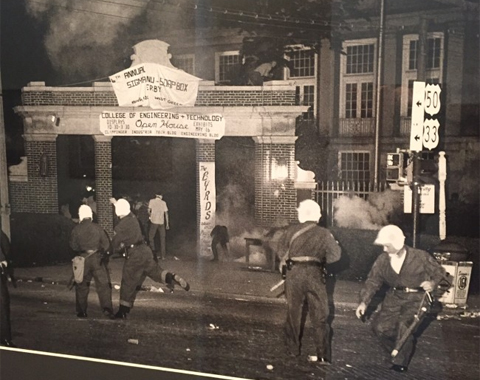
Student protests at entrance to Ohio University in 1970
‘Looking Down the Barrel of the Shotgun’
My parents happened to be in town that evening. My dad was the school superintendent in Vandalia, Ohio, and was to interview prospective new teachers on-campus the next day. My mom came along with him so they could have a visit with me. We had dinner that evening at The OU Inn, where they were staying. I remember my dad telling me to stay away from prospective trouble later that night in uptown Athens. Of course, I ignored his advice.
The riot involved large groups of students uptown, a large police response, tear gas and pepper spray, and lots of windows broken on storefronts (especially the bookstores). For some reason, the Phi Delta Theta fraternity was ransacked. I was circulating around by myself observing from a distance. I do remember standing along a street with other students as a police cruiser drove by. The student standing next to me had part of a brick in his hand. The officer in the passenger seat was holding a shotgun with the barrel slightly extended beyond the rolled-down window. After looking down the barrel of the shotgun as he drove past, I made the decision to go back to my dorm. The student next to me did not throw the brick.
Campus Evacuated, OHIO Closed
Upon returning to my dorm room, my roommates and I were listening to WOUB radio. No one was sleeping. President Sowle delivered a message at approximately 2 a.m. that the University was closing and all students needed to be off campus within a day or two. The National Guard was coming into town later that morning. Students were restricted to campus until they could find transportation to leave town.
Most students, I believe, were as relieved as I was that the campus was closing. Things had become so disruptive that attempts at studying or class work were futile. It was bittersweet because there was little time to say goodbye. I don’t believe I got much sleep that night. Since my parents were in town, I could leave ASAP. So I packed up my stuff and left.
National Guard Arrives at OHIO
My mom, dad, and I drove from West Green through uptown Athens about 7 a.m. We were some of the first parents and students to leave town. The scene was like a war zone, with broken windows and glass all over the sidewalks. My dad was very upset about the destruction. The smell of tear gas and pepper spray was still strong. The National Guard was coming into town via helicopter to Peden Stadium, and trucks with guardsmen were driving in. As I understand it, Athens and OHIO suffered more riot damage than any other campus in the state. There was a real effort to get the students out of town and avoid any confrontation with the National Guard.
In terms of the aftermath, students could take a pass/fail grade for courses they did not complete, or they could complete assignments over the summer for a letter grade. Unfortunately for the seniors that year, the 1970 graduation ceremony was canceled.
The Changing Times
The State of Ohio passed very tough anti-rioting laws specifically aimed at college students.
In the next school year, “hours” for women were gone. The university opened up governing committees to student representatives. I joined “The Building Priorities Committee” that designated to what use campus buildings were put.
Eventually, the voting age was lowered from 21 to 18. The military draft transitioned to a lottery system and then was eliminated entirely as the nation went to an all-volunteer military. Later in the ’70s, the drinking age in Ohio was raised from 18 to 21. And 3.2% beer was no longer brewed, and the Stroh’s Brewery in Detroit closed. Many of the bars in Athens closed. Nationwide efforts against drunk driving were significantly escalated.
Even though the Vietnam War continued beyond the time I graduated in 1973, I remember no further on-campus protests between 1970 and 1973. The U.S. military began withdrawing troops from Vietnam. There were many Vietnam vets who came as students to OHIO during this time. I was friends with a few of them. The ones I knew were not active in protesting or supporting the war. It was almost like that chapter in their life was over and they wanted to move on. Most did not talk about the war.
‘America Sobered Up’
I had the impression that most students blamed President Nixon for our prolonged involvement in the war. (His “secret plan” to end the war was later exposed as a lie.) Ohio students did not blame the soldiers who went to Vietnam to fight.
From a broader perspective, it is almost like some of the freewheeling times of the late 1960s-early ’70s (sex, drugs, and rock and roll) came to end by the late 1970s. America sobered up, and Nixon was disgraced by Watergate. We were then well into the Disco Era and about to enter the time of Reagan conservatism.
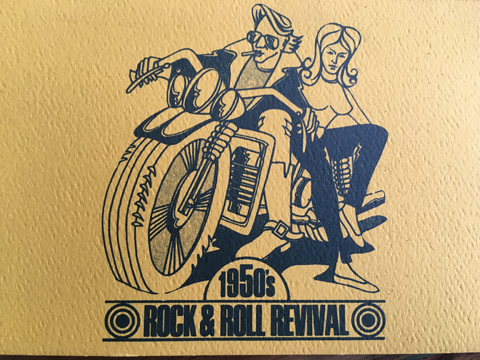
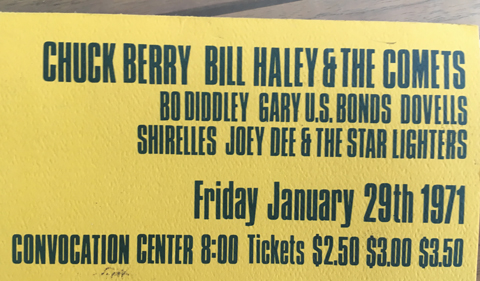
Kent State Shootings Continue to Reverberate
The Kent State shootings evolved into lengthy conflicts in court. A mild apology was given by the State of Ohio to the families of the students who were killed or wounded at Kent State. A small monetary stipend was also given to these families.
No one (including the Governor of Ohio, Ohio National Guard officers, or enlisted men) was really held responsible for the shootings. Several of those killed or wounded could be described as innocent bystanders. Some were just walking to their next class. I don’t believe any of the protesting students were armed with anything more deadly than a rock or bottle. Within the last few years, I have visited the site of the shootings where respectful memorials now exist for the slain students.
With 24/7 cable news, social media, and iPhone video cameras, it makes you wonder how differently these shootings would be covered and viewed by the American public today.
A Surprisingly Organized Coalition
In a way, I am surprised at how organized the protests at OHIO were during this time, considering the lack of social media and other means of communication. I wonder how much influence people outside of the OHIO community had in the protests and riots. Were there “outside agitators” from national groups like the Students for a Democratic Society (SDS)? Was there an orchestrated effort by a few students and/or faculty to create the situations we had at that time? Maybe there were student leaders of the protests, and I just don’t remember who they were or how they did their work. It almost seems like a lot of this was just spontaneous action by a bunch of college kids on a campus in the spring of 1970.
‘Campus Protests…Well Worth It’
In retrospect, the mainstream views of the reasons for the Vietnam War (including the idea that the U.S. was preventing a communist takeover of all Southeast Asia) were proven to be false. We entered the war under false pretenses and had no clear military objectives. The protests of the war (regarded by some as radical and anti-American at the time) are now viewed as probably very justified.
In my view, the protesting students were right and the government was wrong. Unfortunately, over 50,000 Americans and many more thousands of Vietnamese gave their lives before the war came to an end. Many American service members were disrespected for doing their duty and serving in Vietnam. The war was (and remains) an American/Vietnamese tragedy.
If those campus protests in 1970 helped in some way to end the war, then I would say they were well worth it.



















14 Comments